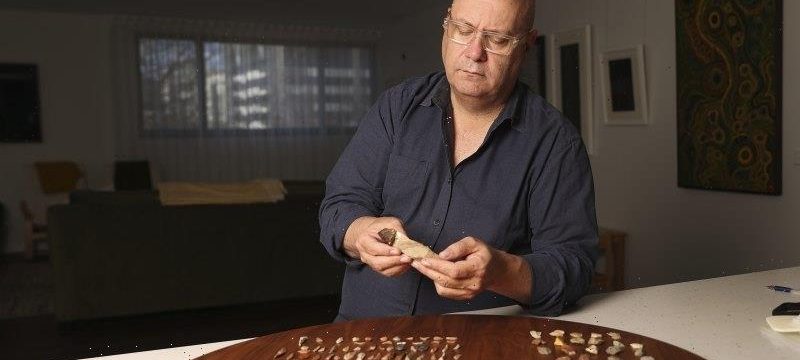Nearly 2000 Indigenous artefacts have been repatriated from overseas galleries, museums and universities after a call out for the return of objects significant to Australia’s cultural heritage.
Those from the single largest collection -1848 objects that were in the Israel Museum in Jerusalem for more than half a century – will be returned to traditional communities by the end of the year.
The items – including ax heads, scrapes and chopping tools thought to be many thousands of years old – are being catalogued. Where clear provenance can be determined, they will in the coming months be returned to Indigenous communities in NSW, Tasmania, Victoria and the Northern Territory.
As well as those already returned, the Australian Institute of Aboriginal and Torres Strait Islander Studies has identified more than 100,000 items in public overseas collections.
The government institute made more than 300 approaches to collecting institutions ahead of the commemoration of the 250th anniversary of Captain James Cook’s 1770 journey to Botany Bay.
Institute of Aboriginal and Torres Strait Islander Studies chief executive Craig Ritchie with Indigenous stone tools.Credit:Alex Ellinghausen
Indigenous affairs minister Ken Wyatt welcomed the objects from the Israel Museum in March.
“Every time we lose an elder or a traditional owner we lose a walking encyclopedia of knowledge that can never be replaced,” the minister said. “When you look at those artefacts you think of the old hands that made those, that person making one spearhead, and then you think of its use. But you also see the engineering feat.”
Eighty-five objects from the Illinois State Museum and Manchester Museum were the first to be returned in 2019 under the pilot project that was launched in 2018 and extended by the Federal Government last year with a grant of $10 million. Sacred men’s items from Manchester Museum will be presented to the Arrernte community in Alice Springs later this month.
More than 1800 items have been returned to Australia.Credit:Alex Ellinghausen
The institute’s chief executive Craig Ritchie has led the repatriation effort.
“These are items that were made to be used, not to be put behind glass for curious Europeans and Americans to look at,” he said. “They are important from an engineering and a historical perspective and very important connections between contemporary communities and their past.”
Mr Ritchie said Indigenous items were originally collected for academic research, driven by the debunked social Darwinist idea that Indigenous cultures were primitive and “that when people were looking at Aboriginal people they thought they were looking at the childhood of humanity”.
When academics went home their collections went with them.
In March, the University of Virginia accepted the institute’s request for the repatriation of 17 items from the Kluge-Ruhe Aboriginal Art Collection. They will arrive in Australia next month to return to Arrernte, Warlpiri and Warumungu communities.
Increasingly, private collectors are also returning materials, most notably a headdress from the Lardil community in the Gulf region gifted by an elderly English collector.
“He is old and he contacted us when he heard about the Manchester Museum returns and the way he put it was, ‘this headdress is talking to me and it is telling me it needs to go home’,” Mr Ritchie said.
The institute is preparing to take receipt of another 81 objects from a private collector in the United States.
Many of those from the Israel Museum’s collection were donated by Carl Shipman, who fled Nazi Germany in 1937 and migrated to Australia before the start of World War II.
Shipman, who became a successful businessman in retail fashion, had a passion for the culture of the indigenous people of Australia and Papua New Guinea.
He is believed to have collected directly from tribal groups or from European dealers, with the core of the collection purchased from a Melbourne auction house in 1976.
The Gweagal Shield, which is held by the British Museum and is believed to have been owned by an Indigenous warrior present during a confrontation with Cook at Botany Bay, has become a symbol of Aboriginal and Torres Strait Islander peoples’ struggle to see culturally significant objects returned.
Mr Ritchie said it was unlikely there would be any progress on the shield’s return while the return of Egyptian mummies and the Elgin Marbles were unresolved.
The Elgin Marbles, one of the most famous exhibits of the British Museum, was excavated from the Acropolis and Greece has since called to have them returned.
“The British Museum is a tough nut to crack and we are pretty unashamedly focused on institutions that have expressed a willingness to engage with us,” Mr Ritchie said.
Mr Ritchie said attempts to repatriate items from the British Museum was “a slow burn”. “There are legislative issues on the UK side which puts restrictions on what an institution can deaccession,” Mr Ritchie said. “The British Museum would likely consider a long-term loan request from an appropriate Australian museum or institution make a request.
“Our objective isn’t to denude overseas institutions of Indigenous cultural heritage because we live in a world where digitisation is such that perfectly acceptable high-level copies of archival materials can be retained by the institution for research purposes.
“To be honest sometimes we go to the institution, ‘When was the last time anybody looked at it?’. And they say, ‘I don’t know. It’s just in storage’.“
Most Viewed in Culture
From our partners
Source: Read Full Article


